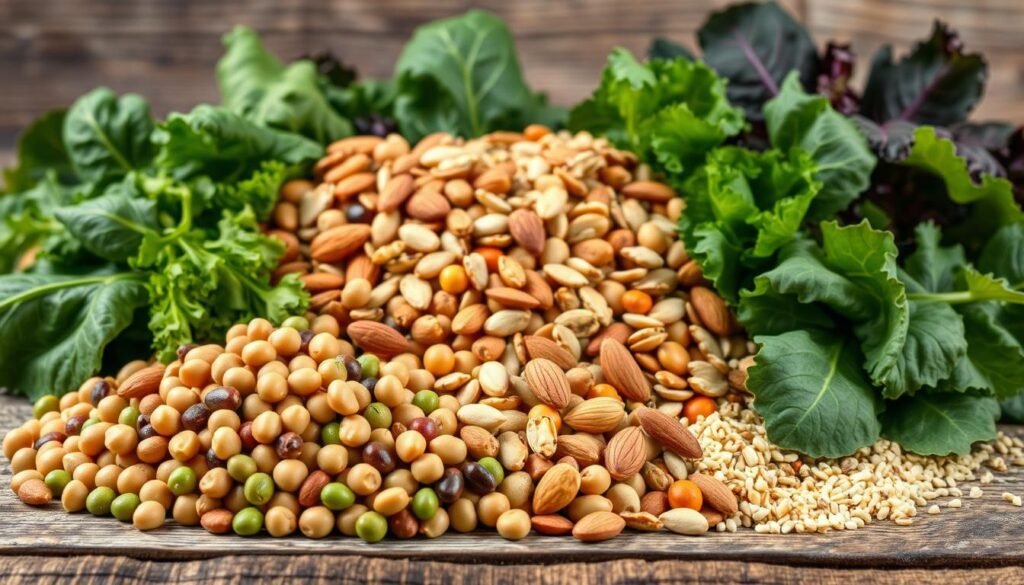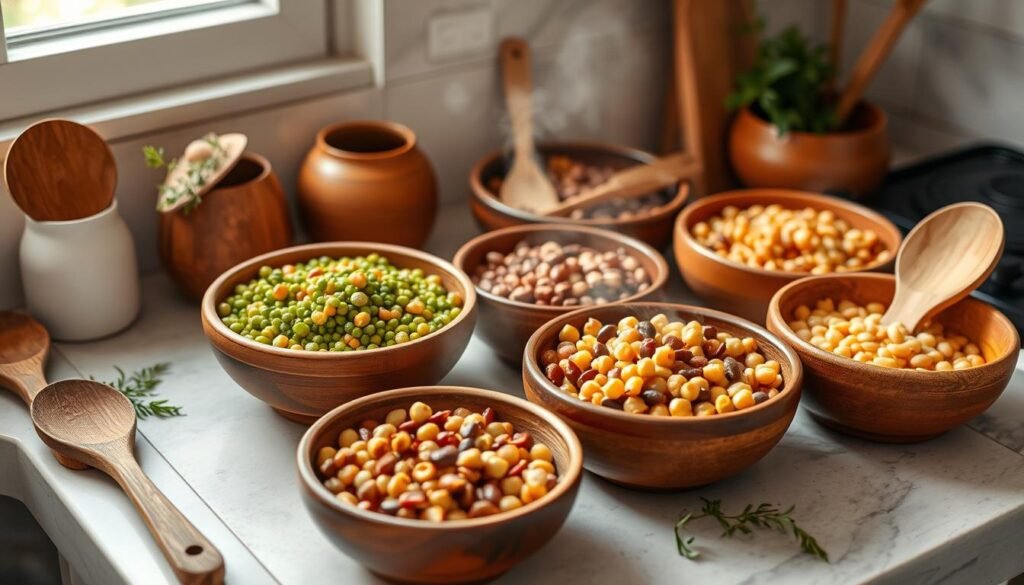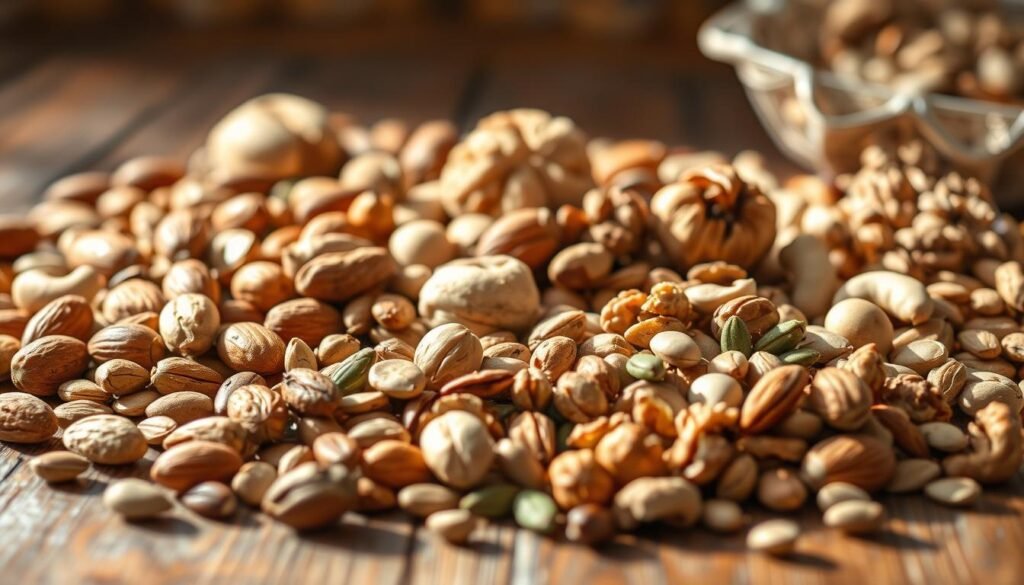Adding plant-based protein to your meals can boost your health. It helps improve your nutrition and supports a green lifestyle.
There are many protein sources to choose from. This makes it easy to switch to a vegan diet without losing taste or nutrition.
Trying out vegan recipes is a great way to keep your diet interesting. It’s a fun and creative way to eat healthy.
Learning how to cook with these protein-rich foods is key. It helps you enjoy a well-balanced diet every day.
Key Takeaways
- Eating plant-based protein can improve overall nutrition.
- Various protein sources are available for a vegan diet.
- Incorporating vegan recipes can be fun and creative.
- A balanced diet with plant-based protein supports a sustainable lifestyle.
- Healthy eating habits can be maintained with protein-rich foods.
The Power of Plant-Based Proteins
More people are choosing plant-based diets, focusing on plant proteins. These proteins are gaining popularity for their health benefits and eco-friendliness.
Why Plant Proteins Matter
Plant proteins are key for vegans and vegetarians. They help build and repair muscles. Plant-based proteins can be as good as animal proteins if you eat a balanced diet.

Nutritional Profile Comparison
Plant and animal proteins have different nutritional profiles. Plant proteins often have extra benefits like fiber, vitamins, and minerals. Legumes are packed with iron and folate, while nuts and seeds offer healthy fats and antioxidants.
“The nutritional quality of plant proteins can be enhanced when consumed in variety, ensuring a complete amino acid profile.”
Protein Requirements on a Plant-Based Diet
Planning is key to meeting protein needs on a plant-based diet. Eating a variety of plant proteins is important. Legumes, whole grains, nuts, and seeds are all high in protein and can be added to meals easily.
Learning about plant-based proteins and how to include them in your diet can lead to a balanced, nutritious lifestyle.
Legumes: The Protein Powerhouses
Legumes, like beans, lentils, and chickpeas, are packed with protein. They are key to a diet rich in plant-based protein.
Beans (Black, Kidney, Pinto)
Beans are both tasty and nutritious. They can be cooked in many ways to boost their taste and texture.
Soaking Methods and Quick-Cook Techniques
Soaking beans overnight cuts down their cooking time. The “quick soak” method boils them briefly, then lets them sit before draining and cooking.
Flavor Enhancement Strategies
Onions, garlic, and bay leaves add great flavor to beans. Spices like cumin, chili powder, and thyme also enhance their taste.

Lentils (Red, Green, Black)
Lentils are a protein-rich option, with different colors and sizes. They cook faster than beans.
Cooking Times and Texture Control
Red lentils cook quickly and become soft. Green and black lentils stay firmer. It’s important to watch cooking time for the right texture.
Chickpeas and Other Legumes
Chickpeas are loved for their use in hummus and salads.
From Canned to Dried: Preparation Tips
Canned chickpeas are easy, but cooking dried ones offers better texture and flavor. Soaking and cooking dried chickpeas can make them more enjoyable.
| Legume Type | Cooking Time | Flavor Enhancers |
|---|---|---|
| Black Beans | 45-60 mins | Cumin, Garlic |
| Red Lentils | 20-30 mins | Turmeric, Ginger |
| Chickpeas | 45-60 mins | Lemon Juice, Paprika |
Whole Grains with Surprising Protein Content
Whole grains are known for their fiber. But they also have a lot of protein. This makes them great for a plant-based diet. Adding these grains to your meals can boost your nutrition.
Quinoa: The Complete Protein
Quinoa is a complete protein. It has all nine essential amino acids that our bodies need. This makes quinoa perfect for those eating plant-based.
Rinsing and Perfect Cooking Ratios
To cook quinoa right, rinse it first. This removes any bitter taste. Use a 2:1 water to quinoa ratio. Cook until the water is gone.
Amaranth and Teff
Amaranth and teff are protein-rich grains to try. Amaranth is not just high in protein but also in minerals like calcium and iron. Teff is full of fiber and protein, making it a healthy choice.
Oats, Barley, and Other Protein-Rich Grains
Oats and barley are known for their fiber. But they also add to your protein.  Mixing different grains into your diet can help meet your protein needs.
Mixing different grains into your diet can help meet your protein needs.
Batch Cooking for Weekly Meal Prep
Cooking grains like oats, barley, and quinoa in bulk saves time. Cook a big batch and then divide it into portions for easy meal prep.
By trying different grains, you can have a balanced and fulfilling plant-based diet. Experiment with various grains and recipes to find what suits you best.
Nuts and Seeds as Protein Sources
Nuts and seeds are full of protein and easy to add to meals. They make great snacks or ingredients in many dishes.

Almonds, Walnuts, and Cashews
Almonds, walnuts, and cashews are tasty and high in protein. For example, one ounce of almonds has about 6 grams of protein. Toasting these nuts can make them even tastier, perfect for snacking.
Toasting for Enhanced Flavor
To toast nuts, spread them on a baking sheet. Bake in a 350°F oven for 5-7 minutes, until fragrant and lightly browned. This brings out their natural oils and flavor.
Hemp, Chia, and Flax Seeds
Hemp, chia, and flax seeds are nutritional powerhouses. Hemp seeds are a complete protein, with all nine essential amino acids. Chia seeds are rich in omega-3 fatty acids, and flax seeds offer fiber and protein.
Nut and Seed Butters in Cooking
Nut and seed butters are great in many dishes, from smoothies to baked goods. Peanut butter, almond butter, and tahini are favorites for their creaminess and flavor.
Homemade vs. Store-Bought Options
While store-bought butters are handy, making your own lets you control ingredients. Avoid added sugars or oils by blending your favorite nuts or seeds until smooth.
Soy Products: Beyond Tofu
Exploring soy products opens up a world of protein-rich foods. You’ll find tempeh, edamame, and more, each with its own unique taste and texture. While tofu is a favorite in many plant-based diets, other soy products add variety and depth to our meals.
Tofu Varieties and Cooking Methods
Tofu comes in different textures, from soft to firm. Knowing how to cook it can make a big difference in its taste and feel.
Pressing and Marinating Techniques
Pressing tofu gets rid of extra moisture. This helps it soak up flavors better. Try marinating it in soy sauce, garlic, and ginger for a delicious taste.
Baking, Frying, and Scrambling
You can bake, fry, or scramble tofu. Baking gives it a crispy outside. Frying makes it golden. Scrambling it with spices and veggies is a great breakfast option.
Tempeh: Fermented Goodness
Tempeh is a fermented soybean product with a nutty taste and firm texture. It’s packed with probiotics and can be used in many dishes.
Steaming Before Cooking
Steaming tempeh before cooking can make it less bitter. Then, you can marinate and cook it in different ways.
Edamame and Other Whole Soy Foods
Edamame, or boiled soybeans, are a tasty and protein-rich snack. Other whole soy foods like soy nuts and soy milk also offer ways to add soy to your diet.
| Soy Product | Description | Cooking Method |
|---|---|---|
| Tofu | Versatile soybean curd | Baking, Frying, Scrambling |
| Tempeh | Fermented soybean product | Steaming, Marinating, Grilling |
| Edamame | Boiled soybeans | Boiling, Steaming |
Plant-Based Meat Alternatives
More people are choosing plant-based diets, leading to a rise in meat alternatives. These options mimic meat’s taste and texture but are animal-free. They’re great for those starting a plant-based diet.
Seitan (Wheat Gluten)
Seitan, made from wheat gluten, is a favorite meat substitute. It has a meat-like texture. You can use it in many dishes, like stir-fries and stews.
Making Seitan from Scratch
To make seitan, mix wheat gluten with water and knead it. This process is both fun and rewarding. It lets you control the flavor and texture.
Commercial Plant-Based Meats
Commercial plant-based meats have become more popular. Brands now offer products that taste and feel like meat. This makes switching to a plant-based diet easier.
DIY Meat Substitutes
Creating your own meat substitutes at home is fun and creative. You can use ingredients like mushrooms, lentils, and grains. This way, you can make alternatives that fit your taste.
Mushroom and Walnut Ground “Beef”
A favorite DIY option is mushroom and walnut ground “beef.” When seasoned right, it tastes and feels like real ground beef. It’s perfect for tacos or pasta sauces.
| Meat Alternative | Main Ingredient | Common Use |
|---|---|---|
| Seitan | Wheat Gluten | Stir-fries, Stews |
| Commercial Plant-Based Meats | Varies (e.g., Pea Protein, Soy) | Burgers, Sausages |
| Mushroom and Walnut “Beef” | Mushrooms, Walnuts | Tacos, Pasta Sauces |
Essential Plant-Based Recipe Techniques
The art of plant-based cooking is all about mastering techniques. These techniques help bring out the best in your ingredients. Whether you’re a seasoned chef or just starting, learning different cooking methods can make your plant-based dishes better.
Batch Cooking Proteins
Batch cooking is a great way to save time. It involves making large amounts of a single ingredient, like proteins, for the week. This is perfect for plant-based proteins like lentils, chickpeas, and tofu.
- Cook lentils and store them in the fridge for up to 5 days.
- Prepare a batch of marinated tofu for easy stir-fries.
- Use pre-cooked chickpeas in salads, stews, or as a snack.
Flavor-Boosting Methods
Improving flavors is key in plant-based cooking. Using spice blends and marinades can make your dishes taste better.
Spice Blends and Marinades
Right spice blends or marinades can change your plant-based meals. For example, a mix of smoked paprika, garlic powder, and thyme can enhance roasted vegetables.
Texture Transformation Techniques
Texture is important for enjoying meals. Techniques like roasting, baking, sautéing, stir-frying, pressure cooking, and slow cooking can change plant-based ingredients’ texture.
Roasting and Baking
Roasting brings out vegetables’ natural sweetness. Baking gives a satisfying crunch on the outside and tenderness inside.
Sautéing and Stir-Frying
These quick methods keep vegetables’ color and texture. They’re great for fast meals.
Pressure Cooking and Slow Cooking
Pressure cooking cooks food fast. Slow cooking tenderizes tougher ingredients over time.
Using these techniques in your cooking can make delicious plant-based meals. Try different methods and ingredients to find your favorite dishes. This will help you grow your cooking skills.
Seasonal and Budget-Friendly Plant Proteins
You don’t have to give up taste or health for less money with plant-based proteins. Seasonal cooking is the secret.
Shopping Strategies for Affordable Proteins
Shop when certain foods are in season to save money. This way, you get fresh produce and cut costs.
Seasonal Cooking Guide
Using seasonal produce can make your plant-based meals better. Lentils are great in winter, while beans and peas are best in summer.
Bulk Buying and Storage Tips
Buying in bulk can also save you money. Grains like quinoa and oats keep well, making them perfect for big purchases.
Freezing Techniques for Different Proteins
Freezing is a smart way to keep proteins like beans, lentils, and grains fresh. The right freezing methods help keep their nutrients.
| Protein Source | Best Season | Storage Tip |
|---|---|---|
| Lentils | Winter | Store in airtight containers |
| Beans | Summer | Freeze after cooking |
| Quinoa | Year-round | Keep in cool, dry place |
Plant-Based Protein Supplements
Looking to boost your protein intake? Plant-based protein supplements are a great option. With more people choosing plant-based products, there’s a wide range of supplements to choose from.
Protein Powders: Pea, Hemp, and Blends
Pea, hemp, and other plant-based protein powders are favorites among fitness fans and those on a plant-based diet. Pea protein is known for its high protein and easy digestion. Hemp protein is a complete amino acid source and packed with omega-3s.
| Protein Type | Amino Acid Profile | Digestibility |
|---|---|---|
| Pea Protein | High in BCAA | Easy |
| Hemp Protein | Complete Amino Acids | Moderate |
| Blend | Varies | Varies |
When Supplements Make Sense
Supplements are great for those needing lots of protein, like athletes. They’re also good for those who find it hard to get enough protein from food. They’re handy for post-workout recovery or a quick energy boost.
Incorporating Powders into Recipes
Protein powders can be added to many recipes, boosting their protein. They’re versatile, from smoothies to baked goods, making them a key part of a plant-based diet.
Smoothies, Baking, and Beyond
Adding protein powder to smoothies increases their nutritional value. In baking, it can make muffins and cakes more protein-rich. Try different recipes to find fun ways to get more protein.
Environmental Impact of Plant Proteins
The move to plant-based proteins is changing our planet for the better. More people are picking plant proteins over animal ones. This is making our environment healthier.
Water and Land Use Comparison
Plant proteins need less water and land than animal proteins. For example, growing a kilogram of lentils uses much less water than growing a kilogram of beef.
| Protein Source | Water Usage (liters/kg) | Land Use (m²/kg) |
|---|---|---|
| Lentils | 1,250 | 2,470 |
| Beef | 15,415 | 27,000 |
| Tofu | 2,517 | 3,400 |
Carbon Footprint Reduction
Plant proteins have a smaller carbon footprint than animal proteins. By choosing plant-based foods, we can cut down our carbon emissions from what we eat.
Sustainable Protein Choices
Choosing sustainable proteins means picking different plant proteins and knowing how they’re made. Choosing local and seasonal plant proteins makes it even better for our planet.
Conclusion: Embracing the Plant-Protein Revolution
Incorporating plant-based proteins into your diet can greatly improve your health and the planet. There are many protein-rich foods like legumes, whole grains, nuts, and seeds. By choosing a plant-based diet, you nourish your body and help the environment.
The plant-protein revolution is more than food choices. It’s a lifestyle change towards being more eco-friendly and healthy. We encourage you to try new recipes and ingredients. This will help you make the most of plant-based proteins.
By choosing a balanced plant-based diet, you join a community working for change. This shift can lead to a better future. We’re excited to support your journey towards a healthier, greener lifestyle.
